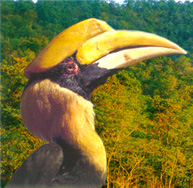 This sub-region comprises Arunachal Pradesh, Assam, Meghalaya, Nagaland,
Tripura, Western ghats, West Bengal and Andaman and Nicobar Islands which
receive heavy rainfall. These areas are covered with evergreen forests. These
forests have three storeyed vegetation. The upper storey consisting of tall and magnetic
trees forms the top canopy receiving most of the sunlight. Trees of lesser height
form the middle storey.
This sub-region comprises Arunachal Pradesh, Assam, Meghalaya, Nagaland,
Tripura, Western ghats, West Bengal and Andaman and Nicobar Islands which
receive heavy rainfall. These areas are covered with evergreen forests. These
forests have three storeyed vegetation. The upper storey consisting of tall and magnetic
trees forms the top canopy receiving most of the sunlight. Trees of lesser height
form the middle storey.They prefer shade and require less height. The thick, dense and rich environment is capable of providing food and shelter to a host of animals of all kinds-the ground dwellers as well as tree dwellers. In the south Nilgiris, Annamalai, Palani hills and other south Indian ranges have extensive grass land dotted with patches of dense evergreen forests. These grasslands are known as sholas. They provides shelter to elephants, gaur and other large animals. Himalayan animals such as tahr, pine marten and European Otter, live here. The Vegetation and animals of the region show affinity height with high altitude forests of Assam.
The other species found in this region are Nilgiri langur, Nilgiri brown mongoose,
stripe-necked mongoose, lion-tailed macaque, slender toris, malabar civet and
spring mouse. In north eastern part, hoolock gibbon and golden langur are found.
Binturong, red-pandas, slow lories are the characteristics of this part. Giant squirrel,
civets and bats also dwell in these tropical rain forests.
 The forests of Andaman and Nicobar islands come under the equatorial belt of tropical
rain forests. Due to their separation from the main land, most of the islands
are free from human settlement. They carry one of the most beautiful forest in
the world. There are about 200 species of trees of which Padauk, Gurjain, silver-gray
etc are prominent. Some of the endemic species of the islands are wild pig,
norcondum,
hornbill, Nicobar-megapode, Andaman teal, Nicobar pigeon, white bellied sea
eagle, Andaman Cat snake, Nicobar legless snake etc. There are 16 species of
bats and 13 species of rats.
The forests of Andaman and Nicobar islands come under the equatorial belt of tropical
rain forests. Due to their separation from the main land, most of the islands
are free from human settlement. They carry one of the most beautiful forest in
the world. There are about 200 species of trees of which Padauk, Gurjain, silver-gray
etc are prominent. Some of the endemic species of the islands are wild pig,
norcondum,
hornbill, Nicobar-megapode, Andaman teal, Nicobar pigeon, white bellied sea
eagle, Andaman Cat snake, Nicobar legless snake etc. There are 16 species of
bats and 13 species of rats.
Constituting nearly 3/4th
of the total numbers of
mammals. The representative of ungulates, squirrels, carnivaora and
larger
mammals are absent. Deer species were introduced in the Island during
1920s. All
of them except Sambar have survived civet was also introduced which has
multiplied to dangerous proportion. The fauna now found are macaque,
palm civet,
spotted deer, barking deer, hog deer, dugong etc. The marine life
consist of crocodile, turtle, coconut-crabs, water monitor, green lizard
and 40 species of snakes
including cobra, viper, coral and sea snakes and pythons.
The highest number of tigers are found in mangrove forest which are found in
Sunderbans delta formed by the estuaries of Ganga and the Brahmaputra. The
animal besides tiger are spotted deer, pigs, rhesus, monkey, lizard, water
monitor, crocodile, crabs and fish . The fish-the mud skipper-can climbs trees.
Weaver ants found here make their nest in the trees. The tiger here is the most
interesting animal which swims in the creeks, preys on fish and crabs besides
spotted deer and wild boar. The tigers here have the propensity of killing human
beings.
The National parks in this region are Balphakram and Norkok in
Meghalaya, Guindy and Marine National park in Tamil Nadu, Sunderbans in West Bengal,
Nandhapha and Mauling in Arunachal Pradesh, Saddle, North Button, Middle Button,
South Button, Marine and Mount Harriet in Andaman and Nicobar Islands, Bhagvan
Mahabir in Goa, Eravikulam,
Periyar and Silent Valley National Parks in
Kerala.
No comments:
Post a Comment